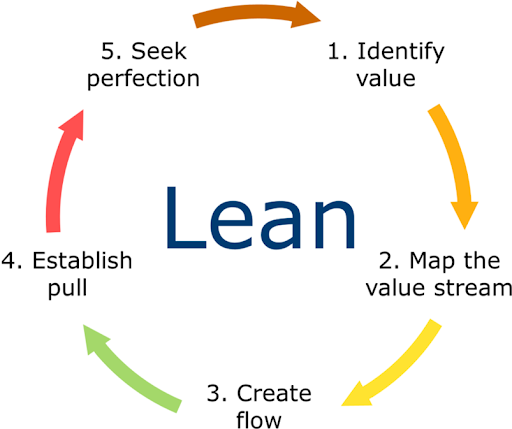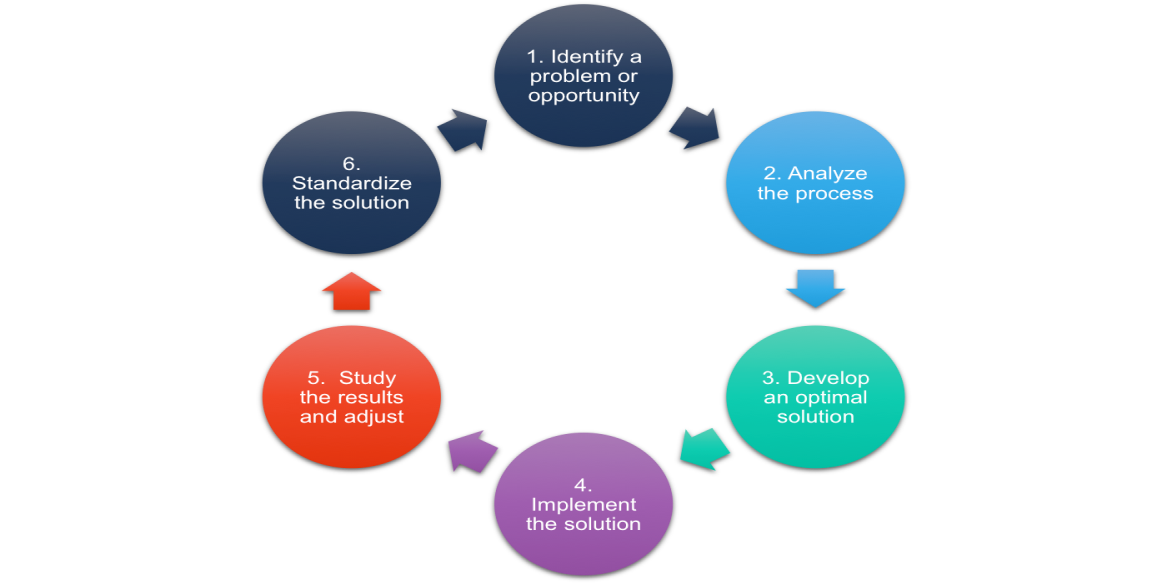Essay on Improvement Methodologies
Number of words: 1349
There are numerous improvement methodologies (theoretical and practical) which businesses consult as they seek to enhance and innovate their processes and output. However, due to the limited scope of this assignment, the two most authoritative improvements methodologies (Lean and Kaizen) have been examined. The processes they use to improve performance will be communicated, as well as critiquing the strengths and weaknesses of each approach in enhancing practice.
Lean
Liker (2004) notes that the lean philosophy has roots in the manufacturing industry, citing Toyota as being the founder of Lean Thinking. The company instituted lean thinking in its manufacturing processes, to improve the value of their product and satisfy customers demands. Liker (2004) elucidates that the process was so successful it was adopted worldwide. As the name implies, Womack and Jones (2007) surmise that lean is primarily concerned with efficiency and eliminating ‘waste’ in the process of producing goods, client interaction and promoting good relationships. However, Womack and Jones (2007) also state that lean is concerned with creating and providing value to customers to satisfy their needs. Womack and Jones (2013) inform that creating value and reducing waste can be achieved through lean by following 5 principles as illustrated below:

(Womack and Jones, 1996)
- Identify value- Crawford (2016) notes that this concerns quantifying the numerical and practical value of the goods/service being offered. This also involves determining the usefulness of the product to customers and considering practicalities like manufacturing and delivery timelines.
- Map the Value Stream- Crawford (2016) defines mapping the value stream as identifying the steps necessary in order to take the product from its raw materials to a finished product which can be marketed to consumers such as design, procurement customer service and delivery. These processes are mapped out with ways of eliminating procedures that do not create value needing to be identified.
- Flow- Womack and Jones (2013) observe that once the value stream has been mapped out, companies need to ensure ‘flow’ in ensuring that the processes run smoothly with no disruptions. Each step of the process needs to be coordinated and synchronised with one another.
- Establish Pull- Womack and Jones (2013) state that the pull component of the lean model ensures that nothing is made ahead of time. This deviates from traditional manufacturing processes, only making a product once a customer orders it.
- Seek Perfection- Womack and Jones (2013) consider this to be the most important part of the process, as it makes the lean process an integral and automatic part of the company’s process with their performance continuously improving.
Whilst there are clear advantages of the lean method in boosting efficiency, reducing waste and pleasing customers, Zarbo (2012) cautions that over 90% of those who attempt to institute lean fail as the philosophy was specific to Toyota and can also be very complex to implement, with improvements tending to be sporadic, rather than consistent among most who try to institute it. Lean is quite sophisticated, and useful in theory, but perhaps not replicated to practice.
Kaizen
Maasaki (1986) notes that the literal translation of the word kaizen from Japanese is ‘change for the better’ (improvement) and is an approach common in many industries. Hill (2011) clarifies that kaizen is an improvement methodology that focuses on incremental continuous improvement in all processes of a company. Womack and Jones (1996) note that kaizen often consults employees in the decision-making process of the improvements that it seeks to institute as it views a harmonious working environment as being crucial to success. It is achieved by following the framework below:

- Identify a problem or opportunity- The first stage of Kaizen is recognising that a problem exists and that consequently there are opportunities for advancement and progression.
- Analyse the process- The next step is to analyse the problem and identify the underlying cause of it, which often involves employing multiple departments to analyse the issue.
- Develop an optimal solution- In the process of creating an optimal solution, proposed solutions are often tested at a small-scale, preliminary level to assess their effectiveness.
- Implement the solution- Once the solution has been developed, it must be implemented across all areas of the company in a slow and gradual manner.
- Study the results and adjust- As the results are implemented at a small-scale level, it is likely that they will have to be adjusted in order to extrapolate the solution to the whole company.
- Standardise the solution- Once all the above steps have been completed, the company needs to consult with its employees to ensure that they are satisfied with the solution. The solution then needs to become a standard part of company process that is easy for people to follow.
(The Lean Way, 2017)
Maazaki (1986) notes that the continuous nature of Kaizen can often make it become an automatic part of a company’s culture. Manos (2007) highlights further advantages of Kaizen in that it is low-cost and often increases employees’ morale and performance. Kelly (2019) notes that the consistent, small improvements Kaizen achieves can lead to considerable long-term improvements. Nevertheless, Maurer (2019) recognises that there are weaknesses to Kaizen, namely that it can be difficult to implement, employees may resist change and cause friction whilst the slow-burn nature of Kaizen could frustrate those wanting success quickly.
Conclusion
Lean and kaizen have clear advantages in improving the practice of an organisation. Lean is primarily concerned with the reduction of waste and promoting efficiency within an organisation whereas kaizen is based on a philosophy of continuous improvement in all areas of a business. However, it seems that there are challenges to implementing the improvement methodologies: lean can be quite complicated and difficult to implement whereas the long-term nature of kaizen may frustrate those who are eager for success quickly. Ultimately, it could be assumed that the success of the improvement methodologies at enhancing the processes of an organisation will depend on the employees’ willingness to adopt each philosophy as often in life people can be resistant to change, even if that change is for the better.
References
Crawford, M. (2016) 5 Lean Principles every Engineer Should Know. (Online). Available at: https://www.asme.org/topics-resources/content/5-lean-principles-every-should-know (Accessed: 17th October 2021).
Liker, J. (2004) The Toyota Way: 14 Management Principles from the World’s Greatest Manufacturer. Saddle River, NJ: McGraw Hill publishers.
Hill, A. (2011) The Encyclopaedia of Operations Management. Upper Saddle River, NJ: Pearson Education.
Kelly, J. (2019) The practice of Kaizen will help you improve 1% each day and lead to amazing long-term success. (Online). Available at: https://www.forbes.com/sites/jackkelly/2019/01/17/the-practice-of-kaizen-will-help-you-improve-1-per-day-and-lead-to-amazing-long-term-success/?sh=3a0eb97759a1 (Accessed: 17th October 2021).
Maazaki, I. (1986) Kaizen: The key to Japan’s Competitive Success. New York: Random House.
Manos, A. (2007) ‘The benefits of Kaizen and Kaizen events’, Quality Progress, 40 (2): 47-48.
Maurer, R. (2019) The Spirit of Kaizen: Creating Lasting Excellence One Step at a time. New York: Mcgraw-Hill Education.
The Lean Way (2017) What is continuous improvement (Kaizen)? (Online). Available at: https://theleanway.net/what-is-continuous-improvement (Accessed: 17th October 2021).
Womack, D. And Jones, D. (1996) Lean Thinking: Banish Waste and Create Wealth in Your Organisation. London: Simon and Schuster.
Womack, D. And Jones, D. (2007) Lean Solutions: How Companies and Customers can create value and wealth together. New York: Simon and Schuster.
Womack, D. and Jones, D. (2013) Lean Thinking: Banish Waste and Create Wealth in Your Corporation. New York: Simon and Schuster.
Zarbo, J.R. (2012) ‘Creating and Sustaining a Lean Culture of Continuous Process Improvement,’ American Journal of Clinical Pathology, 138 (3), pp. 321–326.